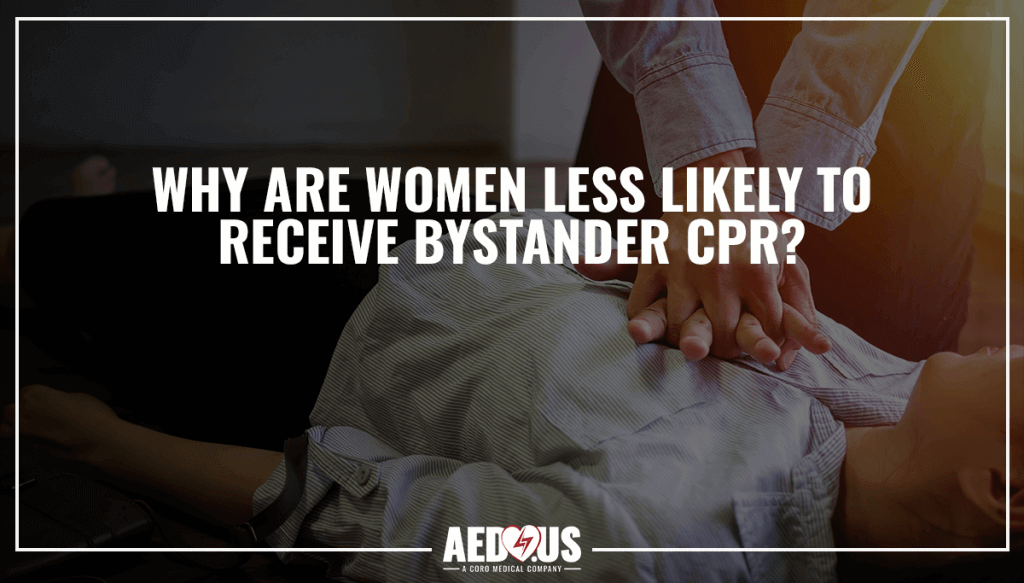Something doesn’t add up: women are at lower risk for sudden cardiac arrest than men, per a 2016 American Heart Association study. But men have a 23% greater chance of surviving an SCA. This same study also revealed that men are more likely to receive bystander CPR. That’s a difference of 6% for SCAs that occur in public.
Bystander CPR Based on Gender
The SCA Foundation did some research to find out what might be at the root of this discrepancy, and they presented their findings at the 2020 AHA Resuscitation Science Symposium. Using a survey of 520 men and women, participants were asked to rank the reasons why a person may not give CPR to a stranger suffering from SCA, based on the victim’s and bystander’s gender.
Responders reported that the main reason men would choose not to give a woman CPR is because they fear inappropriately touching a woman, or in extreme cases, being accused of sexual assault. Women, on the other hand, are afraid of potentially harming the victim. A lesser reason that both genders reported was that people may think women aren’t actually having an SCA, due to misconceptions about prevalence or about the severity of the woman’s condition.
Bystander CPR can double or triple a person’s chances of survival for SCAs that happen in public. There’s no question about it: every person deserves that chance at life. So what do these findings tell us?
Better Training, Higher Survival Rate
Understanding these fears is a tremendous step forward in improving the quality of care for every person. It can inform the way we educate ourselves, families, and communities about CPR. For instance, the chance of harming the victim during CPR is very low. This knowledge may empower more people to initiate that first link in the chain of survival. Additionally, we can make sure that people know that administering CPR is not a form of inappropriate touching or assault. It could be the difference between life and death for a woman. Along those lines, if people are better educated about the signs of an SCA, they may feel more certain that the woman in question actually needs help. Finally, we could train 9-1-1 dispatchers to address and assuage these fears in real time when emergencies happen.
Every person deserves a fighting chance if they have an SCA. Education and proper training, like using the Womanikin, are two of the most powerful tools we have to combat these discrepancies in survivability and to save more lives.
Sources
- Blewer, Audrey L., et al. “Gender Disparities among Adult Recipients of Bystander Cardiopulmonary Resuscitation in the Public.” Circulation: Cardiovascular Quality and Outcomes, vol. 11, no. 8, 2018.
- Perman, Sarah M, et al. “Abstract 139: Understanding Why Differences in the Provision of Bystander Cpr Exist for Women Versus Men: Does the Sex of the Rescuer Matter?” Circulation, 9 Nov. 2020.
Written by Blaire Czarniecki
Customer Service Director
Fact checked by Phillip Woods, BA, NREMT-P, FP-C
Blaire attended the University of Tennessee where she graduated with a Bachelor of Science in Human Ecology- Child and Family Studies. She has been in the Automated External Defibrillator (AED) industry for over eight years and is the Director of Customer Service for Coro Medical. Blaire is also an American Red Cross-certified CPR/AED/First Aid Instructor, highly trained by each manufacturer on their specific AEDs, and knowledgeable regarding ALL State AED regulations and legislation.
“I know that every day I come to work, I am playing a part in saving someone’s life. I am passionate about these devices and am always looking for new and innovative ways to spread awareness and knowledge about Sudden Cardiac Arrest (SCA). I look forward to the day when everywhere I go, I will see an AED—when SCA will no longer take any lives.”
Last updated February 9, 2021







